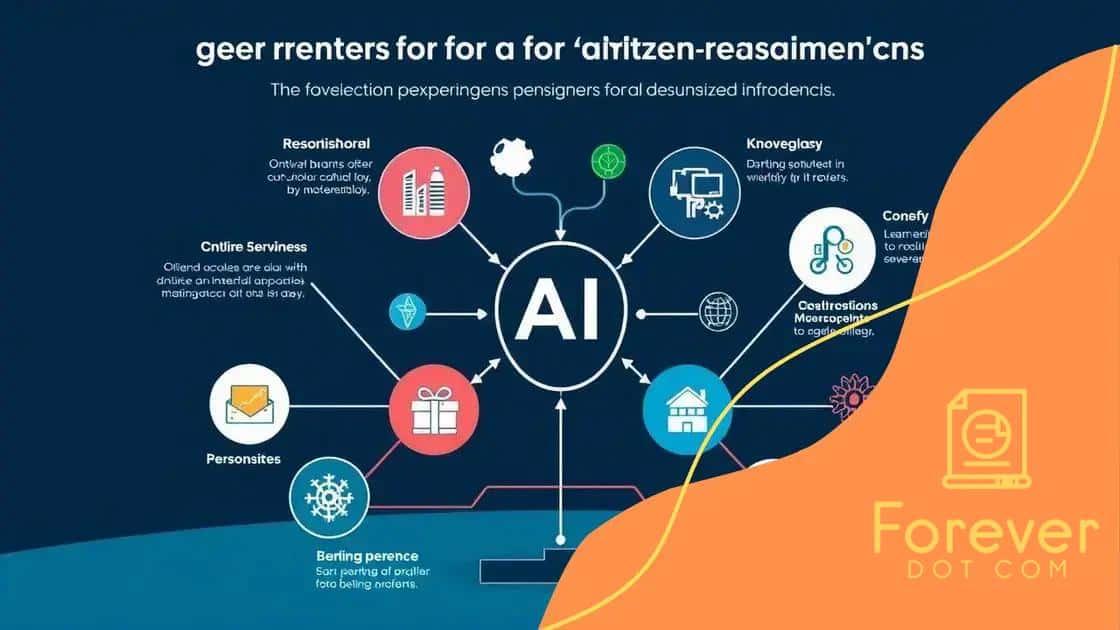Nvidia’s $500B AI investment plan and its implications

Nvidia’s $500B AI investment plan focuses on enhancing AI integration, promoting ethical standards, advancing deep learning, and fostering collaboration, benefiting both businesses and consumers with innovative technologies and improved experiences.
Nvidia’s $500B AI investment plan is more than just a financial commitment; it signals a transformative shift in the tech world. How could this extensive funding impact industries and everyday life?
Understanding Nvidia’s AI investment strategy
Nvidia’s AI investment strategy is integral to its mission of driving innovation in artificial intelligence. This strategy is not just about allocating funds; it’s about shaping the future of technology.
Key Components of the Investment Strategy
The company is focusing on several areas that promise significant advancements. Nvidia’s approach aims to enhance efficiency and performance in the AI sector.
- Research and Development: Investing heavily in R&D to stay at the forefront of AI technologies.
- Partnerships: Collaborating with leading tech firms and universities for innovative solutions.
- Infrastructure: Building robust data centers to support larger AI models.
- Talent Acquisition: Hiring the best minds in AI to drive their vision forward.
Furthermore, Nvidia is exploring applications of AI across various industries. From healthcare to autonomous vehicles, the potential uses are vast. For instance, in healthcare, AI can analyze medical data rapidly, improving patient outcomes.
These investments are also focused on sustainability. Nvidia is committed to creating green technologies within AI. This is part of their larger goal to reduce the environmental impact of tech advancements.
Impact on the Industry
The effects of Nvidia’s strategy can already be observed in the market. Their innovations inspire other companies to explore AI’s possibilities. This ripple effect encourages competition, which can lead to faster technological advancements.
Moreover, with more companies adopting AI, consumers will benefit from improved products and services. Imagine shopping with personalized recommendations that adapt to your preferences thanks to advanced AI algorithms.
Overall, Nvidia’s AI investment strategy is setting the stage for a technological revolution. As they continue to lead in this space, the implications for various sectors will unfold, ultimately shaping a smarter, more efficient world.
Key areas of focus in the $500B plan
The $500B plan set forth by Nvidia identifies several key areas where investments will drive innovation and growth. Each area is carefully selected to enhance technology and expand capabilities.
Artificial Intelligence Research
A primary focus is on advancing artificial intelligence research. Nvidia aims to create more sophisticated algorithms that will change the landscape of machine learning and AI applications.
- Deep Learning Techniques: Developing improved methods for processing data.
- Natural Language Processing: Enhancing AI’s understanding of human communication.
- Computer Vision: Making strides in AI’s ability to interpret visual data.
These advancements in AI research will have a wide-ranging impact on industries, enabling smarter automation and data analysis.
Infrastructure Development
Another critical area is infrastructure development. Nvidia plans to build high-performance data centers that support the growing demand for AI applications. These centers will enhance computational power.
With state-of-the-art hardware, Nvidia aims to provide resources that are essential for large-scale AI projects. As a result, companies will be able to run complex models more efficiently.
Partnerships and Collaborations
Nvidia is also focusing on establishing strategic partnerships and collaborations. Working alongside academic institutions and tech giants allows them to tap into a wealth of information and skills.
- Joint Ventures: Creating innovative solutions through combined efforts.
- Knowledge Sharing: Gaining insights from leading experts in AI.
- Community Engagement: Supporting open-source projects for collective advancement.
This collaboration enhances research potential and accelerates the development of groundbreaking technologies.
Overall, these key areas of focus in the $500B plan are designed to position Nvidia as a leader in AI and related technologies, paving the way for future advancements and business opportunities.
Potential benefits for businesses and consumers

The potential benefits of Nvidia’s $500B AI investment plan extend to both businesses and consumers. By focusing on advanced technologies, Nvidia is poised to unlock new opportunities and efficiencies.
Enhancing Business Operations
For businesses, adopting AI technologies can lead to significant improvements in operations. Companies can streamline processes, reduce costs, and increase productivity. With smarter data analysis, decisions can be made faster and more accurately.
- Automated Customer Service: AI can handle inquiries, freeing up human resources for more complex tasks.
- Predictive Analytics: Businesses can anticipate market trends and customer behaviors.
- Improved Supply Chain Management: AI algorithms optimize logistics, reducing waste and enhancing efficiency.
These innovations empower companies to operate more effectively in competitive markets.
Better Consumer Experiences
For consumers, the implications are equally exciting. As businesses implement AI, customers will enjoy improved products and services. Personalized experiences are on the rise, driven by insights gleaned from data.
Imagine shopping with recommendations tailored specifically to your tastes or accessing support when you need it most without long wait times. AI can make this a reality.
Additionally, enhanced safety measures in areas like transportation and healthcare show great promise. AI technologies can reduce errors and ensure higher standards of safety, ultimately leading to improved overall quality of life.
Driving Innovation Across Industries
Moreover, by pushing boundaries in artificial intelligence, Nvidia’s investments are likely to foster innovation across various sectors. As industries adopt new AI solutions, they will explore unexplored territories, from autonomous driving to advanced healthcare diagnostics.
This creates a cycle of growth where new technologies lead to more advancements, benefiting both consumers and businesses alike.
Challenges and risks associated with the investment
While Nvidia’s $500B AI investment plan holds great promise, it also presents several challenges and risks that must be addressed. Understanding these challenges is crucial for stakeholders and investors.
Regulatory Hurdles
Navigating the regulatory landscape is one of the significant challenges. As governments become more aware of the implications of AI technology, they may impose stricter regulations.
- Data Privacy: Companies must ensure they comply with laws protecting consumer data.
- Ethical Considerations: There are concerns over how AI decisions affect fairness and equality.
- Innovation Stifling: Overregulation can hinder the pace of technological advancements.
These factors can impact not only the cost of doing business but also the feasibility of certain AI applications.
Technological Risks
Another challenge lies in the technology itself. As AI evolves, so do the risks associated with its implementation.
For instance, algorithms can be biased, leading to unfair outcomes. This can result in negative publicity and loss of trust. Continuous monitoring and improvement of AI systems are necessary to mitigate these risks.
Market Volatility
The market for AI solutions is rapidly changing, which presents a risk for investors. Companies can struggle to adapt to shifts in technology and consumer preferences.
- Competition: New players entering the market can affect profitability.
- Changing Technologies: What is revolutionary today might be obsolete tomorrow.
- Economic Factors: Global economic conditions can impact investment in technology.
Companies need to remain agile and ready to pivot in response to market dynamics.
Resource Allocation
Investing such a large amount also poses challenges related to resource allocation. There can be pressure to quickly show results, which can lead to poor decision-making.
With numerous projects under the umbrella of AI investment, prioritizing what to fund can be difficult. Companies must determine where to focus their resources to achieve the greatest impact.
Future trends in AI development and innovation
The future of AI development and innovation is filled with exciting possibilities. As technology advances, several emerging trends are shaping how AI will influence various industries.
Increased Integration of AI
One significant trend is the increased integration of AI into everyday applications. This will make utilizing AI easier for businesses and consumers alike. Everyday tools will evolve to have AI capabilities that enhance usability.
- Smart Assistants: More personalized tools that can help users manage their daily tasks.
- AI in Industries: From agriculture to healthcare, companies will utilize AI to improve efficiency.
- Consumer Products: Household items will become smarter, adapting to user preferences.
This seamless integration will lead to smoother user experiences and more efficient processes.
Focus on Ethical AI
Another important trend is the growing focus on ethical AI. As AI systems become more pervasive, concerns about bias and fairness increase. Developers and companies are urged to create transparent algorithms.
This means implementing guidelines to ensure that AI systems operate fairly and do not cause harm. Ethical AI practices will be crucial in building trust among users and stakeholders.
Advancements in Deep Learning
Advancements in deep learning technologies are also expected to drive future innovation. Techniques like transfer learning and reinforcement learning will allow AI systems to learn from less data while performing complex tasks.
This will open up new possibilities for AI applications, allowing for more sophisticated tools to emerge. Industries can leverage these advancements to create highly efficient systems.
AI and the Internet of Things (IoT)
The convergence of AI with the Internet of Things (IoT) is another area to watch. With more devices connected online, AI can analyze data from multiple sources.
This will lead to smarter decision-making in real time. For instance, smart homes and cities will rely on AI to optimize energy use, enhance security, and improve urban planning.
Collaboration Across Sectors
Finally, collaboration between different sectors will fuel innovation. Industries, academia, and governments are recognizing the potential benefits of working together.
By sharing knowledge and resources, they can accelerate AI development, leading to groundbreaking discoveries that improve everyday life. This collective effort will have a lasting impact on the future of AI.
FAQ – Frequently Asked Questions about Nvidia’s $500B AI Investment Plan
What are the main benefits of Nvidia’s AI investment plan?
Nvidia’s AI investment plan aims to boost efficiency, improve customer experiences, and drive innovation across various industries.
What challenges does the AI investment plan face?
Challenges include regulatory hurdles, technological risks, and market volatility which can affect implementation and growth.
How will consumers benefit from this investment?
Consumers can expect personalized experiences, smarter products, and improved services as AI technologies become more integrated.
What trends are shaping the future of AI development?
Key trends include greater integration of AI into daily applications, a focus on ethical AI, advancements in deep learning, and enhanced collaboration across sectors.






